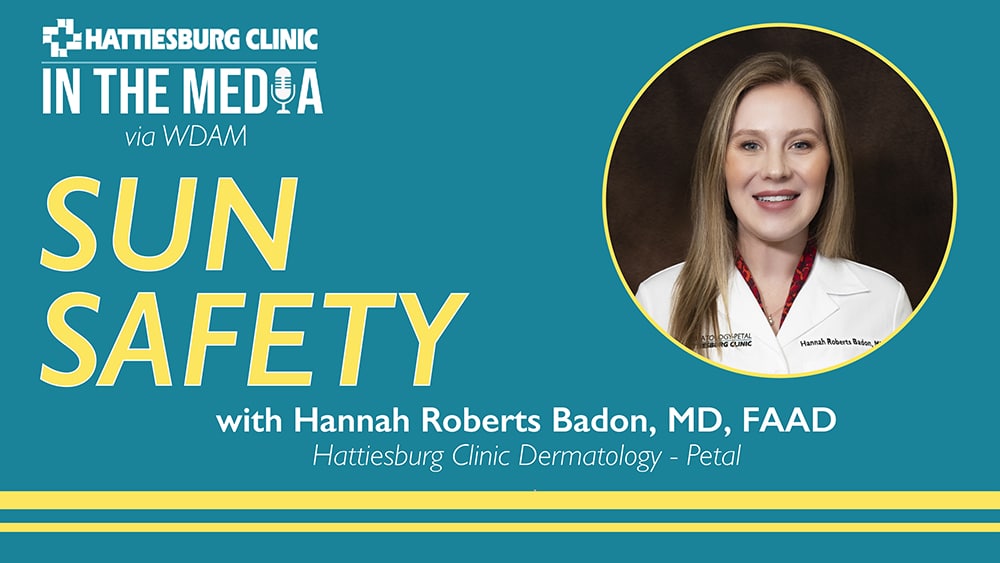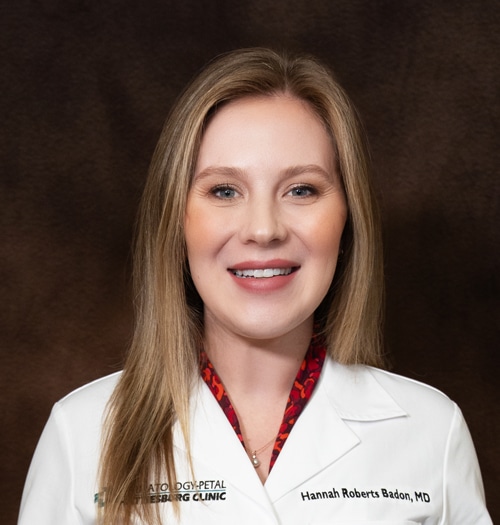How to Stay Sun-Safe This Summer
Mississippi is known for its abnormally hot and humid summers. As Mississippians head outdoors for summer fun, skin protection is more important than ever. Hannah Roberts Badon, MD, FAAD, a dermatologist at Hattiesburg Clinic Dermatology – Petal, is on a mission to help families enjoy the sunshine safely without risking their skin health.
Dr. Badon shares practical advice on skin cancer risks and warning signs, tips on how to protect your skin, and some common myths or misconceptions about tanning and sun protection.
1. Sunscreen is Non-Negotiable—Here’s How to Use It Correctly
Not all sunscreens are created equal, and many people don’t use them effectively. Badon recommends using a sunscreen with broad-spectrum coverage with an SPF of 30 or higher.
“If you’re going to be at the beach or by the lake, I’d say go even higher than that, 50 and up would be great,” she says. “You really need to be applying every two hours, even if your sunscreen says it’s waterproof, sweatproof, etc. You still need to reapply after being in the water, sweating, or toweling off.”
Badon says that her best advice is not about the brand or cost of the sunscreen, but rather choosing a sunscreen you will wear.
2. Myths and Misconceptions
Many believe that a “base tan” is protective, but Badon urges caution. “There’s really no such thing as a protective or a ‘good’ base tan,” she says. “A tan is evidence that DNA damage to your skin has already occurred. Your skin cells produce that tan in response to UV damage and DNA damage in the skin.”
Another popular myth is that sunscreen does not expire. Badon strongly encourages checking the expiration date on sunscreen bottles or cans every year to ensure SPF will be effective.
Another myth is that if you tan easily, you are not susceptible to skin cancer. “Anyone can get skin cancer, you can even get skin cancer in areas that are not exposed often to the sun, places like your palms and the bottoms of your feet,” she adds. “Any changes that occur should prompt a visit to a dermatologist.”
3. Are You at Risk for Skin Cancer? When to See a Dermatologist
Badon says that no one is truly exempt from being at risk for skin cancer. Whether or not you burn or tan easily, exposure to any type of UV rays can increase your risk. Additionally, that risk increases with UV exposure over time.
She encourages everyone to perform regular skin self-checks and look for changes such as new or existing moles, growths, or spots that itch, bleed or will not heal.
“Changes in size, color, texture – those are all signs that point towards some skin damage or skin cancer.”
As the summer season unfolds, Badon’s message is clear: it is not about avoiding the sun completely but rather taking the steps to protect yourself and your skin. With a few easy steps, families can enjoy the outdoors without putting themselves at risk.
For more information or to schedule an appointment, visit hattiesburgclinic.com.
Follow the link to view the full interview on WDAM: https://www.wdam.com/2025/06/11/dermatologist-offers-tips-protect-against-tanning-myths/
###
About Hattiesburg Clinic Dermatology – Petal
Hattiesburg Clinic Dermatology – Petal specializes in comprehensive dermatologic care for all ages, including pediatric dermatology. Our providers are dedicated to the diagnosis, treatment and prevention of various skin-related conditions, including acne, eczema, psoriasis, skin cancer and more. We also offer cosmetic dermatology services aimed to improve skin tone, texture and complexion.
About Hattiesburg Clinic:
Hattiesburg Clinic is Mississippi’s largest privately-owned, multispecialty clinic. Founded in 1963, Hattiesburg Clinic has expanded to include over 450 physicians and providers, along with 2,500 employees, serving patients across more than 17 counties in Mississippi. Hattiesburg Clinic is committed to being the health care provider of choice in the communities we serve.

